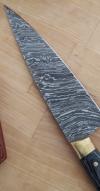- Joined
- Dec 2, 2020
- Messages
- 23
Does fold direction/grain matter relative to the edge?
I know very little about Damascus knives. So I bought one on eBay (and since another) for kitchen use. I don't particularly like it, and it came with a leather sheath so I don't think it was intended for the kitchen. Fortunately my daughter does like it - and she especially likes the sheath.
The Damascus grain/fold direction is not along the length, but angled across the blade. This seems counter intuitive to me as I thought the ideal was to have the cutting steel at on layer.
What is the reason to run the grain this way in a knife?

I know very little about Damascus knives. So I bought one on eBay (and since another) for kitchen use. I don't particularly like it, and it came with a leather sheath so I don't think it was intended for the kitchen. Fortunately my daughter does like it - and she especially likes the sheath.
The Damascus grain/fold direction is not along the length, but angled across the blade. This seems counter intuitive to me as I thought the ideal was to have the cutting steel at on layer.
What is the reason to run the grain this way in a knife?

